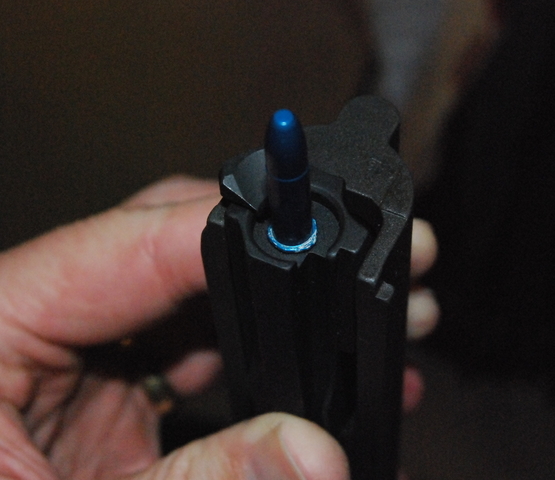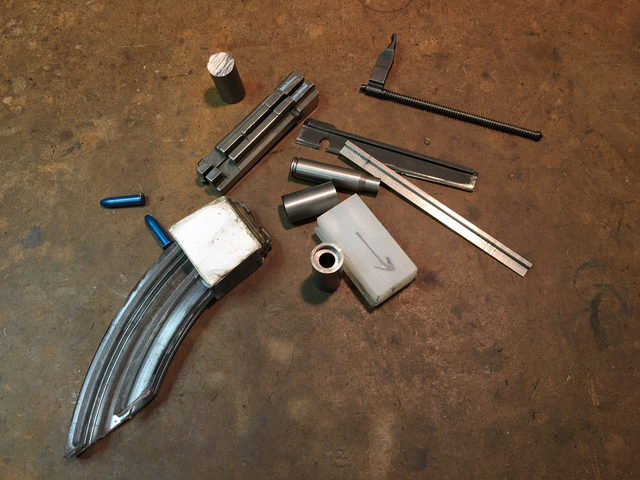Casting Recap
Barrel Alignment
Barrel Exterior
But Weight, There's More
Barrel Liner
Completion and Test Fire
Problem 1: Jamming
Problem 2: Sight Alignment
Problem 3: Unscrewing Barrel
Finishing Up
Conclusion
Appendix 1: Optic
More articles
An Extremely Silly Rifle
I had a problem: There was a rifle I wanted, but it didn't exist, possibly because nobody in his right mind thought it was a good idea. I wanted a dedicated .22 rimfire FAL that was unusually heavy, even by the weighty standards set by FALs' all-steel construction.
The reasoning behind this unusual desire was as follows: FALs are my favorite form of rifle, so I wanted to be good at shooting them. However, .308 ammo is expensive, and even careful practice starts adding up to serious money when each pull of the trigger sends half a dollar downrange. If one could shoot rimfire out of a FAL (provided one could find .22 ammo), then it would be possible to get trigger time that would translate nearly exactly to the centerfire equivalent at a fraction of the cost. The bit about making the rimfire FAL extra heavy had to do with training: After hundreds of rounds of .22 out of a very heavy FAL, a .308 would feel light and nimble in the hands by contrast.
That was the theory, anyway, but it seemed doomed to remain nothing more than theory. Imbel made .22 FALs, but few enough were imported into the US that they cost $6,000 apiece. Cheaper would be one of the .22 conversion kits for FALs; these consist of a .22 barrel insert and blowback bolt unit which slide into an existing .308 rifle, but the last of those had been made decades before and now commanded collector-grade prices. Even if I could find a kit or Imbel .22 and muster up the money and inclination to purchase one, it would still have to use a .308, leaving me with the difficult decision as to whether to weigh down an otherwise practical rifle, or practice with a .22 that merely weighed as much as an all-steel battle rifle. The .22 FAL seemed destined never to exist, but the more I tried to put it out of my mind, the more appealing the idea became. At last I become convinced that the only way to have such a thing was to build it myself.
Early Attempts
Armed with vastly more enthusiasm than skill, I bought a small milling machine and a Coonan Arms receiver and began tinkering with 10/22 parts.

Not much of a resemblance.

Always use the ammo the gun was designed for.
The mangled results of this tinkering still rest in a junk box in case someday the world needs off-brand 10/22 mags missing their sides, chewed-up 10/22 bolts, or sharp bits of FAL bolt carrier rails. The barrel was more successful: I purchased a .22 caliber liner from Brownells and acquired an old Argentine barrel with a ruined non-chrome bore. I ruined it further by removing all the rifling with a 5/16 reamer brazed to a length of drill rod.
The chamber end of the barrel posed more of a challenge. The plan was to use a .308 rimfire chamber insert reamed to accept the liner (I bought an unfinished unit from the manufacturer of such inserts) and use a section of steel rod for the breech face.

Desperation makes for ugly parts.
I didn't yet have a lathe at this point, so facing round stock and drilling a centered hole using only a mill required extremely finicky work. Dissatisfaction with the results joined a growing reluctance to monopolize a perfectly good .308 receiver with homebrew .22 internals. But what choice was there for someone who wanted a .22 FAL?
Two events came to the rescue. First, a fellow going by the name of Kurbelgehause started a group buy on the FALFiles for a remake of the classic .22 FAL conversion kit. I dropped my own efforts like a 300 pound maggot and signed up for a kit. If all else failed, the kit could be dropped into an existing FAL for the desired .22 experience. However, what would I do with this already-reamed barrel and liner? Visions of a weight-enhanced dedicated .22 refused to dispell entirely.
That's when the second part of the equation materialized in the form of a guy selling FAL receiver castings on an online forum. They were inexpensive, didn't even vaguely approach the 80% limit at which a chunk of metal magically transmogrifies into a gun in the eyes of the ATF, and offered a way to make that dedicated .22 without using a .308 receiver. The only thing required was to mill a FAL receiver casting using a bench-top milling machine.
How hard could it possibly be?
email: hidi.projects at gmail.com